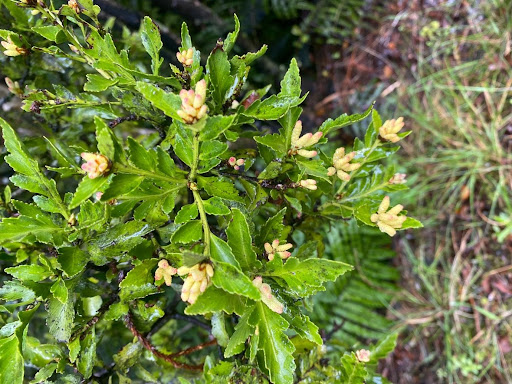20 Dec Reflections: He kohinga whānau
Toi Tangata Kaiārahi Kai Māori Kai Ora, Haylee Koroi, made the move from Auckland to Hokitika earlier this year and has met, named, and can now easily identify at least 30 relatives, from ferns to trees, to shrubs and vines. It has been a beautiful reunion.
We’ve been in Hokitika now for around four months which has been such a huge shift from city living. Our home is located in the dense green bush, a walk away from the glacial lake, Kaniere. The isolation is both comforting given the covid-19 situation and a struggle given the time-space distance from our whānau. In amongst the highs and lows, we’ve felt ourselves being woven into an extended support system, one defined by our more-than-human relations – the Tī Kouka, Kāmahi, Tanekaha and Rātā among many many others. Each relation calling our attention through strong sweet scents, bright cream or red flowers.
Ko ēnei tohu whenua kei te tuku karere ki ngā mokopuna, akuni, ka puta ngā hua! These tohu whenua send a message to us, as they do to other mokopuna of Tāne, that the rākau will soon bear fruit. Whether we harvest from the fruits from our māra, or from the ngāhere, whether we use them for kai or rongoā, it is always good to know and take note of ngā tohu o te whenua and to prepare accordingly. Fruiting times are an important time for our rākau (just as they are important for us) as these hua are eaten, or fall to the ground, contributing to the dispersal of seed, and the setting of the next generation of rākau.
The Māhoe especially, which has buds forming along its stems, has made itself known through its sweet fragrance. I am reminded that our maunga back home is called Taumatamāhoe. This is the same beautiful smell that caught the attention of our tūpuna, and which prompted them to name our maunga. The scent of the Māhoe would be used as a perfume. Following the budding of the flowers, the deep purple berries of the mahoe will start to form. These berries were used in tāmoko ink, and we’ll soon experiment with them to see if they can dye fabrics well.
We visit the same three or four forests across a few weeks and we’ve met, named, and can easily identify at least 30 relatives, from ferns to trees, to shrubs and vines. It has been a beautiful reunion. These are important learnings, we have realized, in restoring whanaungatanga with the ecosystems in which our kai and rongoa grow. We mihi to the pūnaha kai Māori, the Māori food systems which are calling us back into relation, and which we will meet either directly or indirectly on our plates.
What rākau are flowering where you are at the moment? What are your more-than-human relations telling you? How can we use these tohu to prepare for the coming months?

Figure 1: Mahoe flowering, 19 November 2021, Kokatahi 
Figure 2: Matipo flowering, September 27 2021, Otepoti 
Figure 3: Tanekaha Fruiting, 25 October 2021, Kokatahi



